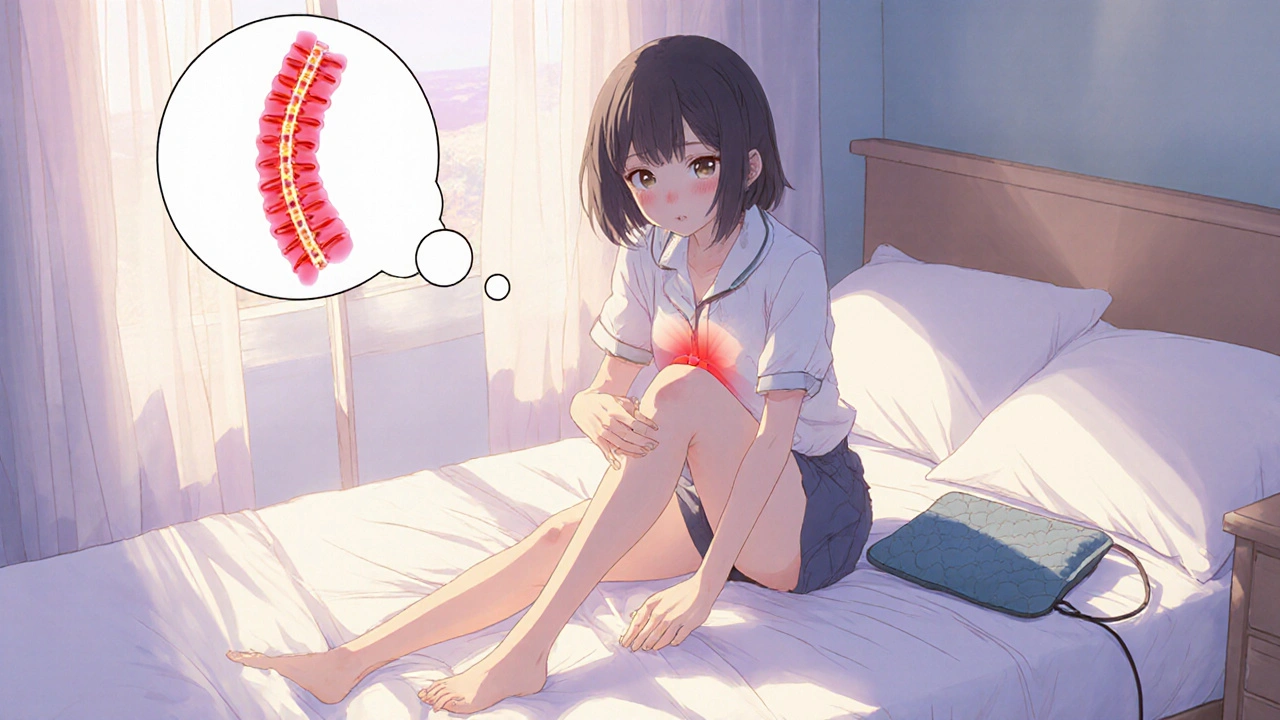When your back pain doesn’t get better with rest-if it actually gets worse when you sit still, wakes you up in the early hours, and leaves you stiff for over an hour in the morning-you’re not just dealing with a bad posture or a pulled muscle. You might be dealing with ankylosing spondylitis, a chronic autoimmune condition that slowly fuses the spine and steals mobility if left unchecked.
What Ankylosing Spondylitis Really Does to Your Spine
Ankylosing spondylitis (AS) isn’t just back pain. It’s inflammation targeting the entheses-the spots where ligaments and tendons attach to bone. Most often, this starts in the sacroiliac joints (where your spine meets your pelvis) and creeps up the spine. Over time, the body tries to heal this inflammation by growing new bone. But instead of fixing the damage, it builds bridges between vertebrae-called syndesmophytes. These bony growths can eventually lock your spine into a rigid, curved position, known as a "bamboo spine." About 30-40% of people with AS develop this kind of fusion within 10 to 20 years. It’s not inevitable, but without the right strategy, it’s a real risk. The disease hits hardest between ages 17 and 45, and men are two to three times more likely to be affected than women. And while the HLA-B27 gene shows up in nearly 90% of Caucasian patients, having the gene doesn’t guarantee you’ll get AS-only about 5% of people with HLA-B27 ever develop the condition.Why It’s So Hard to Diagnose
Most people with AS see four or more doctors before getting a correct diagnosis. The average wait? Over three years. Why? Because the symptoms mimic common back pain. Doctors often mistake it for a herniated disc, muscle strain, or even stress-related tension. But there are clear red flags:- Pain that started before age 45
- Stiffness lasting more than 30 minutes after waking
- Pain that improves with movement, not rest
- Nighttime pain that wakes you up between 3 and 6 a.m.
- Chronic inflammation lasting more than three months
How Medication Helps-And When It’s Not Enough
NSAIDs like ibuprofen or naproxen are the first line of defense. They don’t just mask pain-they actually slow down structural damage. Studies show people who take NSAIDs regularly in the early stages cut their risk of spinal fusion by about half over two years. But if NSAIDs aren’t enough, biologics step in. TNF inhibitors like adalimumab (Humira) or etanercept (Enbrel) and IL-17 inhibitors like secukinumab (Cosentyx) reduce inflammation so dramatically that 40-60% of patients report at least a 40% improvement in symptoms within 12 weeks. The newer JAK inhibitor upadacitinib (Rinvoq), approved by the FDA in 2023, showed a 45% response rate in clinical trials-nearly double the placebo. But these drugs aren’t cheap. Without insurance, biologics can cost $5,000 to $6,000 a month. That’s why many doctors wait until NSAIDs fail before prescribing them. But some experts argue that waiting too long lets damage accumulate. The 2020 C-axSpA trial showed early biologic use reduced new bone growth by 70% compared to delayed treatment.
The Real Game-Changer: Movement
Here’s the truth no one tells you: medication keeps you alive, but movement keeps you free. A 2023 study from the Cleveland Clinic found that patients who did daily, structured exercise improved their spinal mobility by 25-30% in just six months. That’s not a small gain-it’s the difference between tying your shoes and needing help. The most effective programs include:- Spinal extension exercises (lying face down, lifting chest off the floor)
- Deep breathing to keep the rib cage flexible
- Aquatic therapy-swimming or water aerobics reduces joint stress while improving range of motion
- Pilates and yoga designed for AS patients
What You Can Do at Home-No Gym Required
You don’t need fancy equipment. Here’s a simple daily routine:- Morning: Lie on your back, pull one knee to your chest, hold for 10 seconds, then switch. Repeat three times per side.
- Standing: Place hands on hips, gently arch your back backward (like a cat stretching), hold for 5 seconds. Repeat five times.
- Posture: Sit with your back straight, shoulders back. Use a small rolled towel behind your lower back when sitting for long periods.
- Sleeping: Sleep on a firm mattress. Avoid pillows under your knees-keep your spine flat. Some people find sleeping on their stomach helps prevent curvature.
- Heat: Use a heating pad for 20 minutes before exercise to loosen stiff joints.
What Other Conditions Mimic AS?
AS is often confused with other conditions:- Rheumatoid arthritis: Usually affects hands and feet, tests positive for rheumatoid factor, and causes joint swelling-not spinal fusion.
- Psoriatic arthritis: Often involves swollen fingers or toes (dactylitis), nail changes, and skin plaques.
- Mechanical back pain: Gets worse with activity, better with rest, no morning stiffness, no night pain.
- IBD-related arthritis: If you have Crohn’s or ulcerative colitis and back pain, AS could be the link.
What Life Looks Like With AS-Now
Twenty years ago, 45% of AS patients ended up disabled. Today, thanks to early diagnosis, biologics, and consistent exercise, 75% maintain their independence. That’s a massive shift. But it’s not easy. Fatigue is the silent thief. Nearly three-quarters of patients say it’s their biggest challenge-not pain, not stiffness, but exhaustion that makes even simple tasks feel impossible. Work productivity drops. Careers change. Some need to switch to jobs with more flexibility. Support matters. Online communities like MySpondylitisTeam and the Spondylitis Association of America offer free exercise videos, peer advice, and advocacy tools. Access to specialized physical therapy programs-available at major medical centers-is critical. Generic back pain classes won’t cut it. You need AS-specific training.What’s Coming Next
The future of AS care is getting brighter. Researchers are now testing whether 150 minutes of moderate-to-vigorous activity per week (like brisk walking, cycling, or swimming) can prevent fusion better than current guidelines. Early results from the STABILITY trial suggest it can. JAK inhibitors are rising fast. By 2027, they could make up a quarter of the AS treatment market. Digital tools-apps that track posture, remind you to stretch, and log pain levels-are growing at 30% a year. These aren’t gimmicks. They’re lifelines for people trying to stay active on tough days. The bottom line: AS doesn’t have to mean a life of pain and stiffness. With the right mix of medication, movement, and mindset, you can keep your spine flexible, your lungs open, and your life full.Can ankylosing spondylitis be cured?
No, there is no cure for ankylosing spondylitis. But it can be effectively managed. With early diagnosis, consistent exercise, and appropriate medication, most people prevent spinal fusion and maintain a high quality of life. The goal isn’t to eliminate the disease-it’s to stop it from controlling your life.
Is ankylosing spondylitis the same as rheumatoid arthritis?
No. Rheumatoid arthritis (RA) is a seropositive disease that mainly attacks the small joints of the hands and feet, often causing swelling and deformity. AS is seronegative and primarily affects the spine and sacroiliac joints. RA doesn’t cause spinal fusion; AS does. The treatments overlap in some ways, but the goals and progression are very different.
Do I need to stop working if I have ankylosing spondylitis?
Not at all. Many people with AS continue working full-time. The key is workplace accommodations: standing desks, frequent movement breaks, ergonomic chairs, and flexible scheduling. About 42% of AS patients need some form of adjustment, and most employers are legally required to provide reasonable support under disability laws. Communicating your needs early makes a big difference.
Can diet help with ankylosing spondylitis?
There’s no proven AS-specific diet, but anti-inflammatory eating helps. Cutting back on sugar, processed foods, and saturated fats can reduce overall inflammation. Some people report relief with omega-3s (from fish or flaxseed), turmeric, and avoiding nightshades (tomatoes, peppers, eggplant), though evidence is anecdotal. If you also have IBD, a low-FODMAP or gluten-free diet may help gut symptoms that worsen AS.
What happens if I skip my exercise routine?
Skipping exercise for more than a week can lead to rapid loss of mobility. Within days, stiffness returns. After a month, you may lose 10-15% of your spinal range of motion. It’s not just about pain-it’s about keeping your spine functional. Even on bad days, do something: five minutes of breathing exercises or gentle stretches. Consistency beats intensity.
How do I know if my treatment is working?
Track your BASMI score (Bath Ankylosing Spondylitis Metrology Index)-a simple test measuring spine flexibility. Your rheumatologist can do this every six months. You should also notice: less morning stiffness, fewer flares, better sleep, and more energy. If you’re still waking up in pain or can’t turn your head to check your blind spot while driving, it’s time to talk to your doctor about adjusting your plan.







